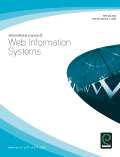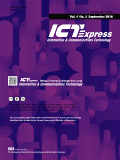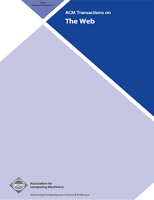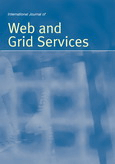
WORLD WIDE WEB-INTERNET AND WEB INFORMATION SYSTEMS
Scope & Guideline
Unveiling Insights in Web Information Systems
Introduction
Aims and Scopes
- Web and Internet Technologies:
Research focusing on the design, development, and evaluation of web and internet technologies, including protocols, frameworks, and architectures that enhance user experience and system performance. - Data Management and Retrieval:
Studies on efficient data management, storage, and retrieval mechanisms in web environments, including methodologies for handling big data, data mining, and information retrieval systems. - Recommendation Systems and Personalization:
Exploration of algorithms and models for recommendation systems that provide personalized content to users based on their preferences and behaviors, utilizing techniques from machine learning and artificial intelligence. - Graph and Network Analysis:
Investigation into the application of graph theory and network analysis to understand complex relationships and interactions within web-based systems, facilitating insights into user behavior and information flow. - Privacy and Security:
Research dedicated to ensuring privacy and security in web applications and services, including privacy-preserving methods, secure data sharing, and the implications of security vulnerabilities. - Artificial Intelligence and Machine Learning:
Application of AI and machine learning techniques to enhance web technologies, focusing on natural language processing, computer vision, and other areas that improve automation and user interaction. - Social Media and Online Communities:
Analysis of social media dynamics, online communities, and their impact on information dissemination, user engagement, and behavior, contributing to a deeper understanding of social interactions in digital spaces.
Trending and Emerging
- Federated Learning:
Research on federated learning is gaining traction, emphasizing collaborative machine learning techniques that preserve user privacy while enhancing model performance across distributed systems. - Knowledge Graphs and Semantic Technologies:
The use of knowledge graphs for improving information retrieval and recommendation systems has surged, highlighting their importance in structuring data and enhancing user interactions. - Privacy-Preserving Techniques:
There is an increasing emphasis on privacy-preserving techniques in data sharing and processing, reflecting growing concerns around data privacy and regulatory compliance. - Multi-modal Learning:
The exploration of multi-modal learning approaches, which integrate data from various sources (e.g., text, images, audio), is becoming popular, advancing the capabilities of recommendation systems and user modeling. - Real-time Data Processing and Analytics:
Research on real-time data processing techniques, especially in the context of streaming data and IoT applications, is emerging as a critical area of focus, given the need for timely insights in dynamic environments. - Social Media Analytics:
The analysis of social media dynamics, including sentiment analysis and trend detection, is on the rise, driven by the influence of social media on public opinion and consumer behavior.
Declining or Waning
- Traditional Database Systems:
Research on traditional relational database systems has become less frequent as the focus shifts towards more scalable and flexible data management solutions, such as NoSQL databases and cloud-based data services. - Static Web Technologies:
There has been a noticeable decline in research focused on static web technologies and basic HTML/CSS frameworks, as the field has evolved towards dynamic, interactive, and responsive web applications. - Basic Web Analytics:
Studies centered around basic web analytics have waned, possibly due to the increasing complexity of user behavior analysis and the demand for more sophisticated analytics involving machine learning and AI. - Generalized User Interface Design:
Research on generalized user interface design principles has decreased, with a shift towards more specialized and context-aware user experience (UX) research tailored to specific applications. - Legacy Systems Integration:
The integration of legacy systems with modern web applications is seeing reduced attention, as organizations increasingly adopt cloud-native architectures and microservices.
Similar Journals

International Journal of Web Information Systems
Fostering collaboration in the world of information systems.The International Journal of Web Information Systems is a distinguished publication dedicated to advancing the field of web information systems, offering a platform for high-quality research and innovative practices. Published by EMERALD GROUP PUBLISHING LTD in the United Kingdom, this journal has established itself as a vital resource for researchers, practitioners, and academics from various disciplines, particularly in Computer Networks and Communications and Information Systems, as evidenced by its ranking in the 2023 quartile assessments (Q3) and Scopus rankings. With an H-index reflecting its impact within the academic community and a publication window spanning from 2005 to 2024, the journal is committed to fostering scholarly exchange and collaboration. While it currently does not have open access options, it provides valuable insights and breakthroughs that are essential for professionals and students navigating the ever-evolving digital landscape.

Big Data Mining and Analytics
Empowering Discoveries with Cutting-Edge AnalyticsBig Data Mining and Analytics, published by TSINGHUA UNIVERSITY PRESS, stands at the forefront of interdisciplinary research in the fields of Artificial Intelligence, Computer Networks and Communications, Computer Science Applications, and Information Systems. With an impressive Q1 ranking in multiple categories as of 2023, this journal serves as a critical platform for researchers and professionals eager to explore innovative techniques and methodologies related to big data analytics. Since its transition to Open Access in 2018, Big Data Mining and Analytics has aimed to increase the visibility and accessibility of its cutting-edge research, making permanent strides in the global academic landscape. Housed in Beijing, China, and actively embracing the converged years from 2018 to 2024, the journal aims to cultivate a rich discourse on emerging trends and applications, ensuring its relevance in a rapidly evolving technological environment. Join a vibrant community of scholars dedicated to advancing the frontiers of knowledge in big data.

Information Security Journal
Leading the Charge in Information Security Knowledge.The Information Security Journal, published by Taylor & Francis Inc, is a pioneering platform dedicated to disseminating knowledge in the realms of information security, computer science applications, and information systems management. With an ISSN of 1939-3555 and an E-ISSN of 1939-3547, this journal has successfully carved its niche within the Q2 quartile of the 2023 rankings for both Computer Science Applications and Information Systems and Management, while also being recognized in Q3 for the Software category. Located in the United Kingdom, the journal has been committed to advancing research and fostering innovation from 2008 through 2024, making it an essential resource for academics and professionals alike. With a significant Scopus ranking in its fields—placing 43rd out of 148 in Decision Sciences and 271st out of 817 in Computer Science Applications—the journal stands as a vital source of interdisciplinary insights. Although it does not currently offer open access options, the quality of publications and the journal's dedication to the field ensure that it remains a compelling choice for researchers seeking to publish their findings or stay abreast of current developments in information security.

COMPUTING AND INFORMATICS
Exploring the Frontiers of Computer ScienceCOMPUTING AND INFORMATICS is a peer-reviewed academic journal published by the Slovak Academy of Sciences Institute of Informatics, focusing on various aspects of computer science and its applications. Established in 2000, this journal has garnered attention for its emphasis on computational theory, computer networks, software development, and hardware architecture, placing it in the competitive landscape of academic publishing with currently a Q3 ranking in the fields of Computational Theory and Mathematics, and Computer Networks and Communications, as well as Q4 ranking in Software and Hardware and Architecture categories. Readers can access its findings through Open Access, promoting wider dissemination of innovative research. With an ISSN of 1335-9150 and an E-ISSN of 1335-9150, the journal serves as a vital platform for showcasing cutting-edge research in the field, aiming to bridge theoretical foundations with practical applications. This journal not only contributes to the academic community but also supports the ongoing advancements in technology and informatics, making it an important resource for researchers, professionals, and students keen on staying at the forefront of the field.

Journal of Information and Telecommunication
Unleashing Insights in Telecommunications and Information Technology.Journal of Information and Telecommunication, published by TAYLOR & FRANCIS LTD, is a distinguished open access journal that has been enhancing the global discourse since its establishment in 2017. With an ISSN of 2475-1839 and an E-ISSN of 2475-1847, this journal is located in the United Kingdom and dedicates its focus to the fields of information technology, telecommunications, and related disciplines. Boasting a respectable Q2 quartile ranking across various categories including Computer Networks and Communications, Electrical and Electronic Engineering, and Computer Science Applications in 2023, it ranks notably in the top percentiles of scopus rankings, asserting its significance in the academic community. The journal's commitment to open access since its inception has fostered widespread accessibility, encouraging research dissemination and collaboration on a global scale. By providing a platform for high-quality research, it aims to unite researchers, professionals, and students in their pursuit of innovation and excellence in the ever-evolving digital landscape.

Internet Technology Letters
Navigating the Evolving World of Internet Applications.Internet Technology Letters, published by John Wiley & Sons Ltd, is a dynamic and rapidly evolving journal that focuses on the innovative applications and developments within the realms of Artificial Intelligence, Computer Networks and Communications, Information Systems, and Software. With its E-ISSN 2476-1508 and a defined convergence period from 2018 to 2024, this journal seeks to address emerging trends and critical challenges confronting the digital landscape today. Recognized in the Q3 quartile range across multiple computer science categories in 2023, it serves as a valuable resource for researchers, professionals, and students seeking to advance their knowledge and stay updated on significant technological advancements. While currently not an open-access journal, Internet Technology Letters holds a prominent position on platforms like Scopus, ranked within the middle percentiles, reflecting its contribution to the academic community. The journal aims to foster connectivity between academia and industry, encouraging submissions that promote interdisciplinary collaboration and innovation. By creating a platform for sharing groundbreaking research, Internet Technology Letters plays a crucial role in shaping future technological landscapes.

KNOWLEDGE AND INFORMATION SYSTEMS
Empowering Innovation through Knowledge and ResearchKNOWLEDGE AND INFORMATION SYSTEMS, published by SPRINGER LONDON LTD, is a distinguished journal in the field of information systems, artificial intelligence, and human-computer interaction. With its ISSN 0219-1377 and E-ISSN 0219-3116, this journal has built a robust reputation since its inception, featuring a convergence of valuable research from 2005 through 2024. Catering to a diverse academic audience, it is classified among the leading journals in its category, proudly holding a Q1 ranking in Information Systems and Q2 rankings in multiple other domains. The journal aims to publish cutting-edge research that not only advances theoretical understanding but also provides practical applications within these rapidly evolving fields. Although it is not an Open Access journal, subscribers can access a wealth of knowledge critical for researchers, practitioners, and students looking to enhance their expertise. With a 2023 Scopus rank placing it within the 66th percentile for Information Systems, KNOWLEDGE AND INFORMATION SYSTEMS is an invaluable resource for those committed to pushing the frontiers of knowledge in technology and information science.

ICT Express
Connecting Ideas, Transforming TechnologiesICT Express is a leading open-access journal published by Elsevier that has established itself at the forefront of the fields of Artificial Intelligence, Computer Networks and Communications, Hardware and Architecture, Information Systems, and Software. Since its inception in 2015, this South Korea-based journal has provided a vital platform for disseminating innovative research and practical applications across these rapidly evolving domains. With an impressive impact factor and consistently high Scopus rankings—placing it in the top quartiles of its categories—it attracts contributions from both seasoned experts and emerging scholars. Current access options ensure that groundbreaking findings are readily available to a global audience, thus fostering collaboration and advancement in technology and computational sciences. As ICT continues to reshape various industries, the significance of research published in ICT Express is crucial for staying ahead in the digital landscape.

ACM Transactions on the Web
Showcasing Excellence in Web Technology ResearchACM Transactions on the Web is a highly regarded journal published by the Association for Computing Machinery (ACM), focusing on the vast and evolving field of web technologies and their applications. With an impact factor that places it in the Q2 quartile of the Computer Networks and Communications category for 2023, this journal ranks #154 out of 395 in its discipline, showcasing its significance in advancing research and knowledge in the domain. Since its inception in 2007 and continuing through 2024, the journal has been dedicated to publishing original research that contributes to all aspects of web-based systems, applications, and services. ACM Transactions on the Web provides an essential platform for scientists, engineers, and practitioners engaged in web research, offering insights into cutting-edge methodologies and emerging technologies. Readers will appreciate the depth and diversity of articles, which encompass both theoretical and applied research, as well as reviews and case studies. The journal's commitment to quality and rigor makes it a valuable resource for anyone invested in the future of web technologies.

International Journal of Web and Grid Services
Unveiling the future of distributed computing.International Journal of Web and Grid Services, published by INDERSCIENCE ENTERPRISES LTD, is a distinguished platform for innovative research in the realms of Web Services, Grid Computing, and Distributed Systems. Established in 2005, the journal has consistently provided a forum for groundbreaking studies, catering to the evolving needs of academia and industry professionals alike. As of 2023, it is positioned in the Q3 quartile in both Computer Networks and Communications and Software, showcasing a notable impact within the field. Researchers will find this journal instrumental in disseminating knowledge, driving advancements, and fostering collaboration in the rapidly changing technological landscape. Although it currently does not offer open access options, its commitment to high-quality peer-reviewed content ensures that it remains a vital resource for those seeking to stay at the forefront of web and grid services research. With an audience comprising both seasoned scholars and emerging professionals, the International Journal of Web and Grid Services continues to be pivotal in shaping ongoing discourse and innovation.